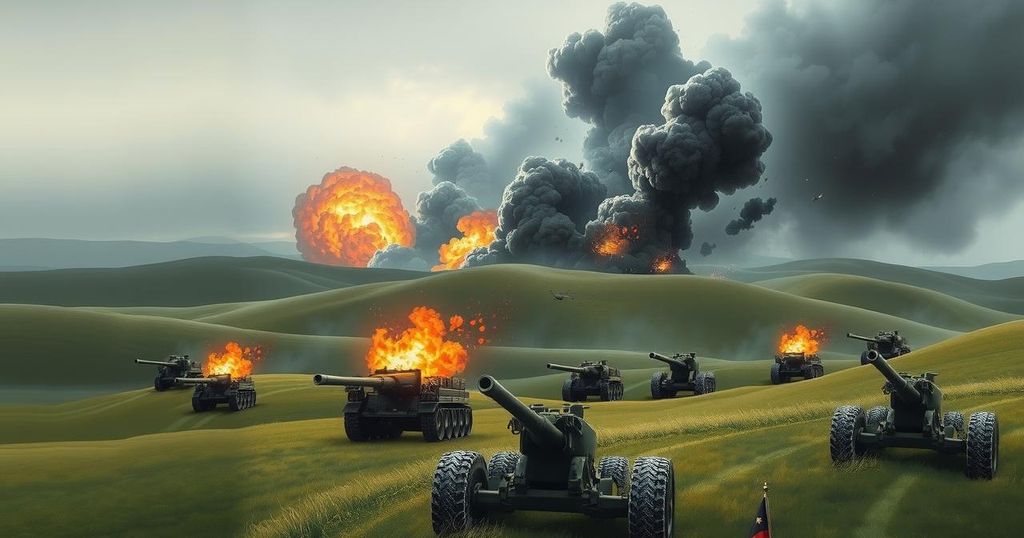Global news
ASIA, DEFENCE, EUROPE, EUROPE/ASIA, FORBES, KOKSAN, KOREA, NORTH, KOREA, SOUTH, KURSK, KURSK OBLAST, KYIV, MILITARY, MILITARY CLASHES, MISSILE ATTACK, MOSCOW, PYONGYANG, RUBICON CENTER OF ADVANCED UNMANNED SYSTEMS, RUSSIA, RUSSIAN ATTACKS, SEOUL, SOUTH KOREA, SUDZHA, UKRAINE, UKRAINIAN 14TH REGIMENT OF UNMANNED AERIAL SYSTEMS, US, WAR
Marcus Li
0 Comments
Ukrainian HIMARS Strike Potentially Damages North Korean Artillery in Kursk
Forbes reports that Ukrainian drone operators may have damaged three North Korean M1989 howitzers in a coordinated strike in Kursk Oblast. Utilizing HIMARS, they targeted the howitzers, which are part of a larger supply of military vehicles delivered by North Korea to Russia. Despite losses, Ukrainian forces continue to retaliate against their opponents in the area.
According to Forbes, the Ukrainian 14th Regiment of Unmanned Aerial Systems recently executed a coordinated strike that potentially damaged three North Korean M1989 howitzers. This operation occurred on or before March 18, when drone operators identified three of the 170-millimeter artillery guns concealed within treelines in Kursk Oblast, Russia.
The drone team relayed the coordinates of the howitzers to a nearby Ukrainian battery, armed with High Mobility Artillery Rocket Systems (HIMARS). With around 40 HIMARS units provided by the United States, the battery initiated an attack using at least one M30 rocket, which detonated above the treetops and released numerous submunitions that cascaded down onto the M1989s and their operators, although the precise extent of damage is currently unknown.
The M1989 Koksan artillery system, a North Korean self-propelled unit weighing 40 tons, was first showcased during a parade in 1989. Its 170-mm caliber allows for an extensive firing range, with conventional shells traveling up to 40 kilometers, while active-reactive rounds can reach distances up to 60 kilometers. Reports indicate that North Korea has provided Moscow with a substantial supply of military vehicles, including M1989s and various missile launchers.
Prior to this recent strike, Ukrainian forces had already destroyed at least one M1989 howitzer and several Bulsae-4 anti-tank launchers. Furthermore, a Russian drone operator inadvertently destroyed one of North Korea’s air defense systems due to a miscommunication. Meanwhile, a significant Ukrainian force maintained a position in Kursk until they were targeted by the Rubicon Center of Advanced Unmanned Systems, which severed their main supply line in Sudzha. A concurrent advance by North Korean troops further destabilized the situation for Ukrainian forces, compelling a retreat and the loss of valuable equipment.
Despite these setbacks, Ukrainian drones and artillery persist in targeting Russian and North Korean forces in the region. Forbes characterizes the Kursk offensive as a Pyrrhic victory for the Russians and North Koreans, who reportedly faced tens of thousands of casualties while forcing the Ukrainian retreat, with Ukrainian losses being comparatively less severe.
In summary, the conflict in Kursk has seen significant military engagement between Ukrainian and advancing Russian-North Korean forces. The purported strike by Ukrainian drones against the North Korean M1989 howitzers highlights ongoing hostilities. Despite suffering losses, Ukrainian forces continue to conduct operations against their adversaries, indicating a sustained effort in the region.
Original Source: euromaidanpress.com




Post Comment